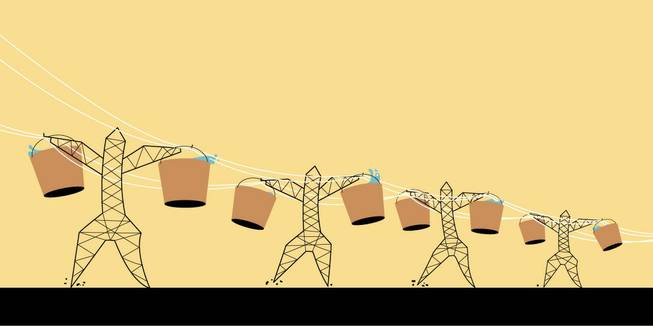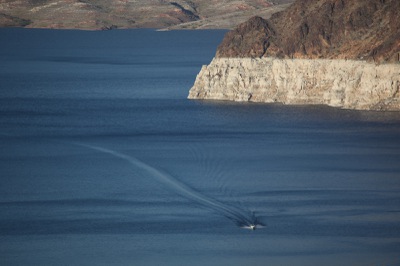Tuesday, Oct. 20, 2009 | 2 a.m.
Nevada renewable energy map
Sun Archives
Sun Coverage
Southern Nevada has gained a reputation as the future of clean, renewable energy and for its aggressive outdoor water conservation campaigns.
But behind this apparently eco-friendly exterior is an ugly truth: The water we take from and return to Lake Mead every day requires a massive output of electricity, much of it generated from fossil fuels.
Energy experts across the country are starting to look at just how the nation’s water supply systems affect electricity consumption, the strain they put on grids and the amount of greenhouse gas emissions that come from the treatment and transporting of water. It was one of the topics at the 2009 Water Smart Innovations conference held in Las Vegas this month.
About 25 percent of America’s electricity goes to moving and treating water, according to a 2005 California Energy Commission report.
California passed a law three years ago that is aimed, in part, at the electricity burned to move and treat water. The legislation requires greenhouse gas reduction for water utilities, which have been instructed to make their operations more energy efficient and to incorporate renewable energy. With population growth, demand for water and water treatment are expected to grow. At the same time water treatment standards are expected to become stricter. That all adds up to a prediction that the energy demand for water will continue to grow significantly.
As municipal water systems attempt to rein in costs and improve conservation, many of them are starting to look more closely at the nexus between water and energy. Engineers and number-crunchers across the country are conducting energy audits on their water utilities and water audits on their energy utilities to give cities and states better ideas about how water management can be incorporated into their energy conservation initiatives.
But so far, that hasn’t been done in Southern Nevada despite the fact that the cost of energy for treating and delivering water accounts for 12.6 percent of the Las Vegas Valley Water District’s operating budget and despite predictions by water engineers and managers from across the nation that water management will be the next area the feds will target in a bid to reduce greenhouse gases and stress on electrical grids.
About 90 percent of the Las Vegas Valley’s water comes through a network of pipes, pumped many miles from Lake Mead to treatment facilities then to homes and businesses. The other 10 percent is pumped up from the ground and sent through the same network of pipes and treatment facilities. What goes down the drain is then pumped to wastewater treatment facilities, to golf courses or back to Lake Mead.
With its reliance on pumping, Southern Nevada provides a prime example of just what a strain on electricity resources — and what a huge carbon footprint — water management can have.
The energy used to pump and treat water in the Las Vegas Valley dwarfs any other type of local electric consumption.
Southern Nevada used about 853.8 million kilowatt-hours of electricity in 2008 to move 439,187 acre-feet of water into valley homes and businesses, according the Southern Nevada Water Authority. Another 119.2 million kilowatt-hours of electricity was used that year to treat 22,501 acre-feet of water and send it back to the lake, according to figures from the Clean Water Coalition, a consortium of local wastewater agencies.
A kilowatt-hour is enough energy to power a 100-watt lightbulb for 10 hours. One acre-foot is about the same amount of water the average Las Vegas Valley home uses in two years.
Southern Nevada used 2,107 kilowatt-hours for every acre-foot, or 325,851 gallons, of water delivered, treated and sent back to the lake last year. Nationally, most agencies use between 652 and 6,517 kilowatt-hours per acre-foot, according to Lisa Maddaus, a senior engineer with environmental engineering firm Brown and Caldwell.
Another way of looking at it: The amount of electricity used to move and treat water in Southern Nevada annually is enough to power the entire valley several times over.
It’s a huge amount of energy that comes from a variety of sources. Eighty percent of it is generated by the water utilities at renewable and fossil-fuel-powered power plants.
So every gallon of water wasted also means energy wasted, unnecessarily dirtier air and more climate-changing gas sent into the atmosphere.
And because you need water to make electricity from fossil fuels, it also means more water wasted to replace the wasted water.
Water managers in Las Vegas know this. About 14 percent of the energy used to pump water from Lake Mead to area homes is generated by renewable energy plants, most of them hydro-powered.
And more self-generation is in the works.
Henderson plans to have the first local wastewater treatment facility using renewable power. The city recently got federal funding to build a 4-megawatt solar installation to help power its wastewater treatment facilities and to install turbines in some of its downhill-sloping water pipes to generate electricity emission-free from the flowing water.
Local water managers across the valley are also hoping water users will do their part by switching out their water-hogging landscapes, installing low-flow faucets and buying energy- and water-efficient appliances.
Those changes could do a lot more good — in many more ways — than most people realize.



Join the Discussion:
Check this out for a full explanation of our conversion to the LiveFyre commenting system and instructions on how to sign up for an account.
Full comments policy